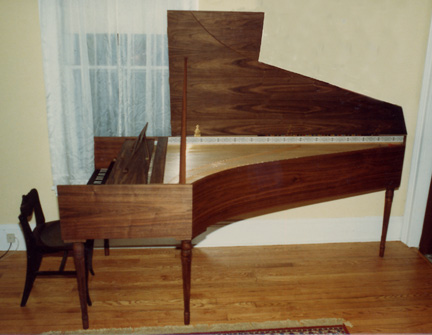 |
Historical Tuning of Keyboard Instruments |
 |
Robert Chuckrow, Ph.D. (physics)
The main systems of tuning, their qualities, and why and when they should be used.

A two manual harpsichord constructed by Robert Chuckrow.
 |
Historical Tuning of Keyboard Instruments |
 |
Robert Chuckrow, Ph.D. (physics)
The main systems of tuning, their qualities, and why and when they should be used.

A two manual harpsichord constructed by Robert Chuckrow.
• Why not use equal temperament for all music?
• Summary of Equal-Temperament, Meantone, and Well-Temperament systems.
• Graphical comparison of frequencies in different tunings/temperaments.
• Aron-Neidhardt 1/4 syntonic comma Well Temperament: Download a simple scheme for tuning it.
• Thomas Young 1/6 ditonic comma Well Temperament 2: Download a simple scheme for tuning it.
• Meantone Temperament: Download a simple scheme for tuning it.
• The distinction between a tuning and a temperament.
• Information about Robert Chuckrow’s book on historical tuning (enables even those with very little knowledge of music theory or mathematics to achieve a historical and theoretical understanding of tuning and the ability to tune in meantone and well temperament).
• Why the octave of a note sounds the same but higher in pitch.
• Beats: Understand and hear them.
• Harmonics of a vibrating string and their frequency relationships (with audio illustrations).
• Understand why tempered intervals beat (with audio illustrations).
• Understand why octaves are stretched.
• Decibels: An intuitive explanation.
• Links to other web sites on historical tuning.
• Information on recordings of music in historical temperaments.
• The Prenatal Underpinnings of Music
• Visit Robert Chuckrow’s web site on T’ai Chi and other health-related subjects.
• email Robert Chuckrow at: rmp (at) bestweb (dot) net.
• Phone Robert Chuckrow: 914-762-2810
This website was updated on November 10, 2022.